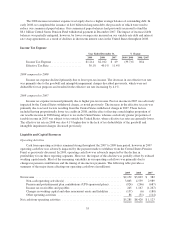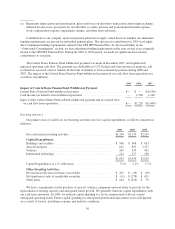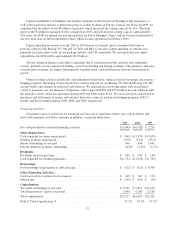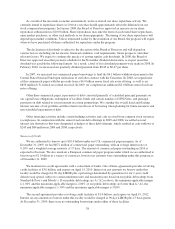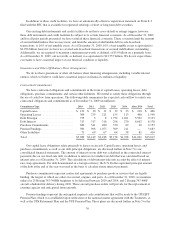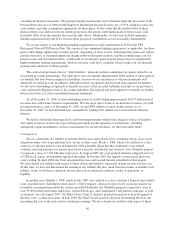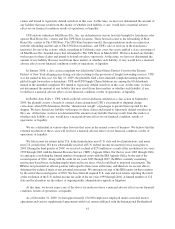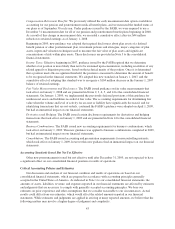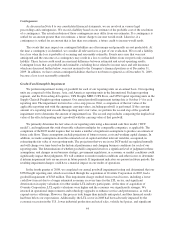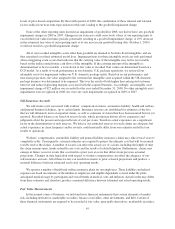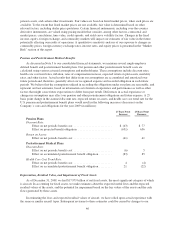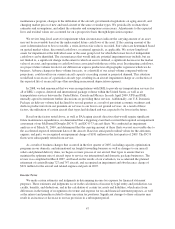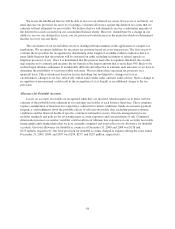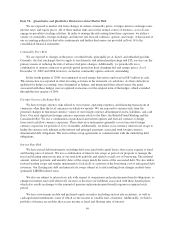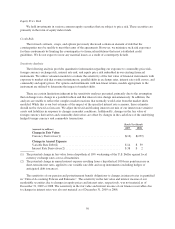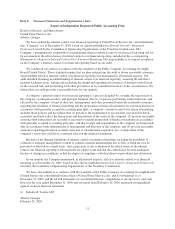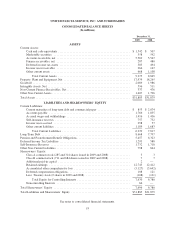UPS 2009 Annual Report Download - page 57
Download and view the complete annual report
Please find page 57 of the 2009 UPS annual report below. You can navigate through the pages in the report by either clicking on the pages listed below, or by using the keyword search tool below to find specific information within the annual report.levels of price-based competition. By the fourth quarter of 2008, the combination of these internal and external
factors reduced our near term expectations for this unit, leading to the goodwill impairment charge.
None of the other reporting units incurred an impairment of goodwill in 2008, nor did we have any goodwill
impairment charges in 2009 or 2007. Changes in our forecasts could cause book values of our reporting units to
exceed their fair values in future periods, potentially resulting in a goodwill impairment charge. A 10% decrease
in the estimated fair value of our reporting units as of our most recent goodwill testing date (October 1, 2009)
would not result in a goodwill impairment charge.
All of our recorded intangible assets other than goodwill are deemed to be finite-lived intangibles, and are
thus amortized over their estimated useful lives. Impairment tests for these intangible assets are only performed
when a triggering event occurs that indicates that the carrying value of the intangible may not be recoverable
based on the undiscounted future cash flows of the intangible. If the carrying amount of the intangible is
determined not to be recoverable, a write-down to fair value is recorded. Fair values are determined based on a
DCF model. As a result of weak performance in our domestic U.K. package operations, we reviewed our
intangible assets for impairment within our U.K. domestic package entity. Based on recent performance and
near-term projections, the value assigned to the customer list intangible asset acquired within the UK domestic
package business was determined to be impaired. This was the result of both higher than anticipated customer
turnover and reduced operating margins associated with the acquired business. Accordingly, an intangible asset
impairment charge of $27 million was recorded for the year ended December 31, 2008. No other intangible asset
impairments were recognized in 2008, nor were any such impairments recognized in 2009 or 2007.
Self-Insurance Accruals
We self-insure costs associated with workers’ compensation claims, automotive liability, health and welfare,
and general business liabilities, up to certain limits. Insurance reserves are established for estimates of the loss
that we will ultimately incur on reported claims, as well as estimates of claims that have been incurred but not yet
reported. Recorded balances are based on reserve levels, which incorporate historical loss experience and
judgments about the present and expected levels of cost per claim. Trends in actual experience are a significant
factor in the determination of such reserves. We believe our estimated reserves for such claims are adequate, but
actual experience in claim frequency and/or severity could materially differ from our estimates and affect our
results of operations.
Workers’ compensation, automobile liability and general liability insurance claims may take several years to
completely settle. Consequently, actuarial estimates are required to project the ultimate cost that will be incurred
to fully resolve the claims. A number of factors can affect the actual cost of a claim, including the length of time
the claim remains open, trends in health care costs and the results of related litigation. Furthermore, claims may
emerge in future years for events that occurred in a prior year at a rate that differs from previous actuarial
projections. Changes in state legislation with respect to workers compensation can affect the adequacy of our
self-insurance accruals. All of these factors can result in revisions to prior actuarial projections and produce a
material difference between estimated and actual operating results.
We sponsor a number of health and welfare insurance plans for our employees. These liabilities and related
expenses are based on estimates of the number of employees and eligible dependents covered under the plans,
anticipated medical usage by participants and overall trends in medical costs and inflation. Actual results may differ
from these estimates and, therefore, produce a material difference between estimated and actual operating results.
Fair Value Measurements
In the normal course of business, we hold and issue financial instruments that contain elements of market
risk, including derivatives, marketable securities, finance receivables, other investments, and debt. Certain of
these financial instruments are required to be recorded at fair value, principally derivatives, marketable securities,
45


